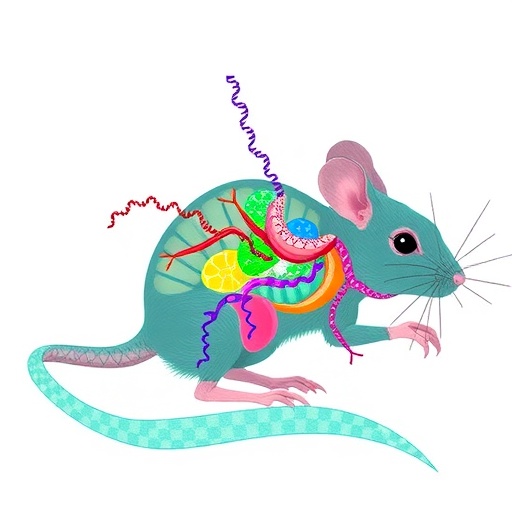
In a groundbreaking study published this year, scientists have unveiled compelling evidence suggesting that RNA molecules can transfer from the liver to the kidney in mice. This remarkable discovery challenges traditional views of intracellular RNA localization and has the potential to reshape our understanding of inter-organ communication at the molecular level. Using an innovative sequencing technique called SLAMseq, researchers have mapped RNA movement with unprecedented precision, opening new avenues in molecular biology, disease research, and therapeutic development.
For decades, the scientific consensus maintained that RNA, as a crucial intermediate in the central dogma of biology, typically exerts its functions within the confines of the cell in which it was transcribed. While extracellular vesicles and circulating nucleic acids had hinted at a degree of intercellular RNA trafficking, definitive evidence for direct RNA transfer between distant organs remained elusive. The current study pierces this veil by demonstrating that specific RNA species synthesized in the liver appear subsequently in the kidney, suggesting an inter-organ RNA exchange paradigm previously unappreciated.
Central to this discovery is the application of the SLAMseq methodology, which stands for “thiol(SH)-linked alkylation for the metabolic sequencing of RNA.” This technique leverages chemical labeling to track newly synthesized RNA molecules with exquisite temporal resolution. By metabolically labeling RNA in the liver and sequencing it from downstream tissues, the researchers could definitively identify RNA molecules originating from hepatic cells that later localized in the kidney, proving a directional RNA transfer mechanism in vivo.
.adsslot_qjWTnJZL3K{width:728px !important;height:90px !important;}
@media(max-width:1199px){ .adsslot_qjWTnJZL3K{width:468px !important;height:60px !important;}
}
@media(max-width:767px){ .adsslot_qjWTnJZL3K{width:320px !important;height:50px !important;}
}
ADVERTISEMENT
The significance of this technique cannot be overstated. Previous methods to study RNA trafficking often relied on indirect markers or were confounded by the complexity of in vivo systems. SLAMseq allowed for a direct and time-stamped capture of nascent RNA molecules, differentiating them from resident transcripts and enabling a dynamic view of RNA distribution across tissues. This advancement marks a milestone in RNA biology, turning a previously abstract concept into tangible, measurable processes.
Delving deeper into the liver-to-kidney RNA transfer, the researchers observed that not all RNA species were equally transported. Certain messenger RNAs (mRNAs), microRNAs (miRNAs), and long non-coding RNAs (lncRNAs) were preferentially transferred, hinting at a selective mechanism governing RNA export and import between these organs. This selectivity implies functional roles for the transferred RNAs in modulating gene expression and cellular activity in recipient kidney tissues.
The physiological implications of such RNA transfer are profound. The liver is a metabolic powerhouse, regulating lipid metabolism, detoxification, and protein synthesis, while the kidney plays a critical role in filtration and homeostasis. The potential for the liver to communicate molecular instructions via RNA to the kidney suggests a previously unrecognized layer of regulation that could fine-tune renal function in response to systemic metabolic states or stress signals.
Intriguingly, the study also pointed to the involvement of extracellular vesicles, small membrane-bound particles known to mediate intercellular cargo shipment, in facilitating RNA transfer. The researchers hypothesize that these vesicles act as RNA shuttles, protecting fragile RNA cargo from degradation in the circulation and delivering messages intact to distant cell populations. This mechanism aligns with emerging data on extracellular vesicles as central players in intercellular communication.
Moreover, this inter-organ RNA transfer could have critical implications for disease pathogenesis and progression. Aberrant RNA trafficking might contribute to pathological signaling in chronic kidney disease, liver fibrosis, or systemic inflammatory conditions. Understanding the molecular determinants that govern RNA loading into vesicles and reception by recipient cells could reveal therapeutic targets to interrupt maladaptive molecular dialogues between organs.
Technological advancements like SLAMseq are key to unlocking these biological mysteries, providing tools not only for descriptive studies but also for dissecting mechanistic pathways. Future research employing this method may explore whether similar RNA transfer events occur between other organ pairs, such as heart and lung or brain and liver, thus broadening the impact of these findings into systemic physiology and pathology.
The researchers caution, however, that while evidence for RNA transfer is compelling, understanding the functional consequences remains an open challenge. Are these RNAs translated into proteins in recipient cells? Do they modulate gene expression epigenetically? Or are they merely molecular relics without significant biological activity? The answers to these questions will set the stage for a new research frontier.
In addition to clarifying functional outcomes, deciphering the molecular signals governing the packaging of specific RNAs for export and recognition mechanisms in target tissues will be critical. This demands interdisciplinary approaches combining molecular biology, bioinformatics, and systems biology to map RNA trajectories and interactions comprehensively.
The discovery also sparks interest in translational applications. Can this natural RNA transfer pathway be harnessed or mimicked to deliver therapeutic RNA payloads to targeted organs? If so, it could revolutionize RNA-based therapeutics by enabling systemic, organ-specific delivery without invasiveness or systemic toxicity.
Notably, this study raises foundational questions about the stability and lifespan of extracellular RNAs in the bloodstream, systemic biodistribution, and cellular uptake mechanisms. Understanding these aspects will inform both basic science and clinical strategies targeting RNA transport and communication.
The insights gleaned also challenge the dogma that organs operate in isolation molecularly, underscoring the complex, interconnected nature of organismal biology. RNA-based signaling pathways may represent a critical but underappreciated axis of physiological regulation beyond classical hormones and metabolites.
Finally, this research underscores the importance of technological innovation in revealing hidden biological processes. As methodologies like SLAMseq become more sophisticated and widespread, they will undoubtedly continue to unveil assumptions and dogmas in biology, imparting new perspectives on how life orchestrates its multifaceted molecular symphony across cellular and organ systems.
This pioneering work thus not only documents RNA transfer from liver to kidney but also opens a portal to a richer understanding of molecular communication in multicellular organisms. It marks a step forward in molecular biology, promising to shape future research, diagnostics, and therapeutics in the years to come.
Subject of Research: Inter-organ transfer of RNA molecules in mice, focusing on RNA movement from liver to kidney
Article Title: SLAMseq reveals potential transfer of RNA from liver to kidney in the mouse
Article References:
Hunter, R.W., Sun, J., Palmer, T. et al. SLAMseq reveals potential transfer of RNA from liver to kidney in the mouse. Nat Commun 16, 7413 (2025). https://doi.org/10.1038/s41467-025-62688-9
Image Credits: AI Generated
Tags: direct RNA transfer evidenceextracellular vesicles and RNAinnovative RNA sequencing techniquesinter-organ communicationintercellular RNA traffickingliver to kidney RNA exchangemetabolic sequencing of RNAmolecular biology breakthroughsRNA localization in cellsRNA transfer between organsSLAMseq methodologytherapeutic implications of RNA transfer





